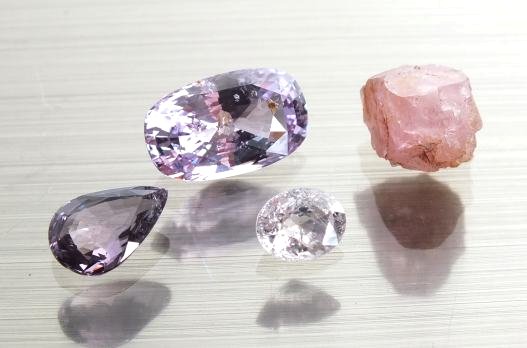 |
| Taaffeite 0.78 - 3.69ct 結晶 3.88ct 9.5x7.2x6.6mm |
| Srilanka |
ターフェ石とマスグレイヴ石
(Taaffeite & Musgravite)
 |
| Taaffeite 0.78 - 3.69ct 結晶 3.88ct 9.5x7.2x6.6mm |
| Srilanka |
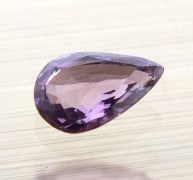 |
 |
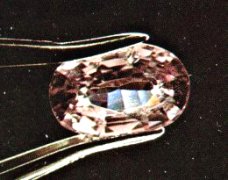 |
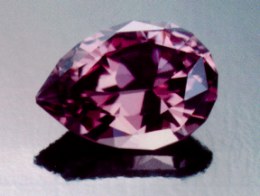 |
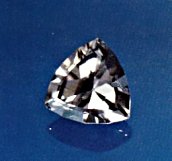 |
| 典型的な淡紫色の ターフェ石 1.29ct 9.1x6.2mm Typical mauve color taaffeite |
スピネル結晶を包有する ターフェ石 3.69ct 12x7.2mm Taaffeite with spinel crystal inclusion |
1979年当時は稀な大きさの ターファイト 2.71ct Rare large taaffeite at 1979 |
ターフェ石 0.67ct |
無色のターフェ石 0.61ct 1987年発見 Colorless taaffeite discovered in 1987 |
| Srilanka | ||||
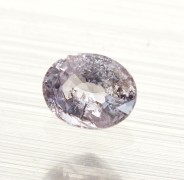 |
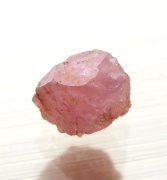 |
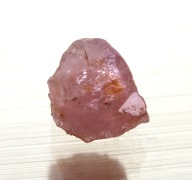 |
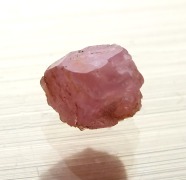 |
| 0.78ct 6.2x5.0x3.5mm | ターファイト結晶 (Taaffeite Crystal) 3.88ct 9.5x7.2x6.6mm | ||
| 化学組成 Formula |
結晶系 Crystal System |
モース硬度 Hardness |
屈折率 Refractive Index |
複屈折 Birefringence |
比重 Density | |
| Taaffeite | BeMg3Al8O16 | 六方晶系 Hexagonal |
8 | 1.717-723 | 0.004-006 | 3.58-62 |
| Musgravite | BeMg2Al6O12
or (Mg,Fe+2,Zn)2BeAl6O12 |
六方晶系 Hexagonal |
8 | 1.719-726 | 0.007 | 3.61-69 |
| Spinel | MgAl2O4 | 等軸晶系 Cubic |
8 | 1.712-762 | - | 3.58-90 |
ターフェ石の発見 (Discovery of Taaffeite)
ターフェ石(Taaffeite:ターファイトと発音されます)が発見されたのは1945年、アイルランドの鉱物愛好家、ターフェ伯爵が宝石商のルースの包みを調べていた時に、スピネルに似ている青みがかかった紫色の宝石が複屈折を示す事に気付きました。
しかしスピネルなら等軸晶系の鉱物で複屈折は起りません。複屈折を示すとなれば明らかに結晶系の異なる別の鉱物です。
その後の研究により新鉱物と確認され,発見者の名に因むターフェ石と名付けられました。
実は0.004〜0.006と言う複屈折は大変小さな値で、ジルコンや橄欖石、方解石のような桁違いに大きな複屈折を持つ鉱物とは異なり、肉眼でファセットされたルースの稜線が二重に見えるという事はありません。
スピネルとターフェ石の屈折率と比重の違いは個々の石による測定誤差の範囲内に入ってしまう程小さなものです。
したがって、ごく僅かな複屈折の有無に気付いて新鉱物の発見に至ったターフェ伯爵の鑑識眼と測定能力とはアマチュアの鉱物愛好家としては一流であったと言えましょう。
*ターファイトの発見については米、Gems & Gemology誌1952年 Summerに英宝石学協会の B.W.Andersonがその経緯を詳しく書いていますので抜粋を紹介します ;
(An extract about taaffeite discovery episode on Gems & Gemology Summer 1955 article written by B.W.Anderson, B.Sc., F.G.A.)
ターフェ伯爵は第二次世界大戦中は英国宝石学協会の通信教育を受けていた熱心な宝石愛好家であり、Andersonは彼の指導員であリました。 伯爵の、設問に対するきっちりとした解答と、乏しい測定機類やアカデミックな科学訓練を受けてなかったにも拘わらず、卓越した測定技術を持っていたことが印象に残っていたと記述しています。
伯爵が所持していたのは最大21倍の実体双眼顕微鏡のみで、屈折率計は持っていなかったと。しかしながら機材の不足ゆえに、鋭敏な観察眼が養われたのだろうと述べています。
伯爵は古い宝飾品から取り外された宝石を買うために1945年の10月に友人の宝石商を訪れ、ジャンクボックスの中に収められた、それぞれ毎日100個程度の宝石を数日かけて自宅に持ち帰って調べていました。それらの宝石はブルージルコン、オパール、ガーネット、黄水晶、紫水晶、スピネル、タイ・ルビーと下級品のエメラルドやサファイア等でありました。
伯爵は持ちかえった宝石を洗浄し、21倍の実体双眼顕微鏡で一つ一つ精密に観察していましたが、淡紫色のスピネルを観察していた時にルースの背面についた擦り傷とごみが僅かに二重に見えることに気づいて不審に思いました。 何故なら等軸晶系のスピネルが複屈折を示すことはあり得ないからです。 続いて比重の測定です。 標本の石は沃化メチレン液(比重3.32)では沈みました。クレリチ液(蟻酸タリウムとマロン酸タリウムの混合物で比重4.2〜4.3)がなかったので静水法で測定しました。ポケット型の天秤による10回の測定の平均で3.62と算出しました。英宝石学協会の研究室での測定結果は3.613でしたから、粗末な天秤での3.62は驚くべき精度です。 更に伯爵は屈折率計を持っていなかったので沃化メチレン液にこの石を浸した時の見え方から屈折率はほぼスピネルに近いとターフェ伯爵は推定しました。 しかし(スピネルが)複屈折を示す理由が分からなかったので、詳細な測定結果と共にこの石を英国自然史博物館の鉱物部門に送りました。
研究所での測定の結果、この1,419ctの淡紫色の宝石の比重は3.613、屈折率は1.717 と1.721、複屈折率は0.00475、モース硬度は8,X線散乱と化学分析により、六方晶系の酸化アルミニウム・マグネシウムにベリリウムが加わった新鉱物であることが確認されました。
Count Edward Charles Richard Taaffe has for many years been a keen gemologist, as a corresponding student of the Gemmological Association of U.K. during the War, when I was an instructor. I used to enjoy his original, racy replies to the set questions, and soon became aware that, despite his paucity of apparatus and lack of academic scientific training, he was a gemologist of quite unusual skill.
One day in October 1945 Count Taaffe called on Mr. Robert Dobbie, a jeweller friend, for the purpose of buying some of the stones broken from old jewelry, which were stowed away in various "junk boxes."The searching and sorting took several days, and each day 100 or so stones were taken home. These were a very mixed bag. Blue zircons, opals, garnets, citrines, amethysts, sopinels, a few Siam rubies, and poor quality emeralds and sapphires.
At home, Taaffe throughly cleaned the stones and roughly sorted them according to color. The stone which eventually became known as taaffeite was put in the little box containing violet and lilac stones. Each stone was scrutinized under microscope on white paper, wtih illumination from above provided by an adjustable table lamp with metal reflector. The specimen in question, which looked like a pale mauve spinel, puzzled him by showing small, but quite distinct, "doubling" of scratched and dust particles at the back of the stone. This was a remarkably acute piece of observatio considering the power of the microscope was only 21x the stoneless than one and one half carats, and the birefringence(as later established) less than .005. Next followed density tests. The stone sank in methylene iodide, and no Clerici solution was available, so hydrostatic determinations were made with a pocket balance in which the tassel had to be held by hand while the weighing was in progress. The average of ten determination was 3.62. As dour final figure obtained in the laboratory proved to be 3.613, this also was evidence of good work under difficult conditions. No refractometer was available, but the low relief in methylene iodide showed that the reflactive index must be near that of spinel. There remained the puzzle of the double refraction, which was confirmed by a test between crossed nicols, which showed normal extinction of 90°. Finally Count Taaffe decided to send the stone to me at the Laboratory, stating the result of his tests, and asking
"could anomalous double refractions sto strong ?"新鉱物が、結晶からではなく、カットされたルースから発見された事実も稀なる出来事でありました。
そんなわけでターフェ石の発見は宝石史上でもユニークなエピソードとして注目を集め、多くのコレクターが探し求めることになりましたが、極めて稀産の鉱物で、2個目の発見は1949年で0.87カラットの石が、1980年代初頭には世界で10個程度、1983年頃でも大半は1〜3カラット、最大でも10カラットの石全てを合計して50個程が報告されている程の稀少な宝石でした。
しかし1990年代後半には産地で注意深く選別しているためでしょう、依然として稀少な宝石ではありますが世界各地のフェアで数個から10個ほどは見かけるようになりましたから、現在では数千個程はあるでしょう。
また最近では10カラットを越える大きなルースも珍しくは無く,1992年9月には香港のオークションで33.33カラットもの大きなルースが出品されました。
This episode that new mineral is discovered from faceted stone, not from crystal specimen was an extremly rare occasion, resulting in many collectors to verify their collections. However, taaffeite was such a rare mineral and 2nd stone was discovered in 1949 as 0.87 carat and even in 1980's in total 10 stones, and maximum 50 stones word's wide averaging 1 to 3 carats, and the largest ever reported was 10 carat by 1983.
However, by end of 1990's, it is not rare to encounter several stones at major gem show in the world.
It is estimated that there exist several thousands of faceted stones in the world. And large stones weighing more than 10 carats are not exremely rare. The largest faceted taaffeite appeared was 33.33ct shown at September 1992 Auction in Hong Kong.ターフェ石の産地 (Taaffeite localities)
最初に発見されたターフェ石はスリランカ産と推定され、その後も殆どのルースはスリランカからの産出です。
しかし1963年には中国の湖南省、1977年に東シベリア、1980年にオーストラリアのMt. Painter地方からの発見が報告されています。 そして1983年のビルマと1996年のタンザニアのトゥンドゥルーからは宝石質の結晶発見が報告されるなど、徐々に世界各地での発見が報告されています。
ターフェ石が発見されるのは変成作用を受けた石灰岩や角閃岩,柘榴石花崗岩中ですが、もっとも,産出の多いスリランカの場合は全て初成鉱床ではなく,二次鉱床の漂砂鉱床で採れるため母岩が何であるのかは不明です。
First taafeite discovered by Count Taaffe is estimated as Srilankan origin and almost all follwing stones are discovered in Srilanka. But in 1963, taaffeite was discovered in Hunan Province, China, then 1977 in eastern Siberia, in 1980 from Mt. Painter, Australia.
Gem quality stones outside Srilanka were reported, in 1983 from Burma and in 1996, in Tunduru, Tanzania
Taaffeite is discovered in metamorphic lime stone, amphibole and garnet-granite. But in case of major producer Srilanka, geologic origin is unknown, because of discovery in alluvial deposit.赤いターフェ石の発見 (Discovery of red taaffeite)
0.58ct
1990 Srilanka1.23ct 1.78ct 2.26ct 4.02ct 3.17ct 0.33ct 1.04ct 0.89ct
ターフェ石の多くは淡いモ‐ヴ色です。 余り魅力の無いスピネルに酷似していて、宝石として必ずしも魅力ある色合いとは言えません。 が、その珍しさの為にコレクターが求める宝石の筆頭に挙げられます。
1981年に0.33カラットの赤い鉱物が発見され、ターファイトに似た新しい宝石、Taprobaniteとして国際鉱物学連合によって正式に登録されました。
しかしながら、後にその化学組成分析が誤りであって,実はクロムを含むターファイと判明しました。
淡いモ‐ヴ色の発色は主に酸化鉄イオンによりますが、濃い紫〜赤の発色は酸化クロムイオン発色によります。
上右の写真で,大きい方から順に4.02と3.17ctの二つの紫のターフェ石は酸化鉄のみを0.8〜2.1%含む発色ですが、他の6個は1.3〜2.7%の酸化鉄に加えて0.1〜0.35%の酸化クロムを含み濃い紫から赤を示します。
本来稀産のターフェ石で、その上クロムを含む濃い紫から赤い色のターフェ石は1981年の報告以来、2000年初頭までの20年間に10個程度しか報告されてないという、極め付きの稀少な宝石です。
今のところ全てがスリランカ産です。
Most of taaffeite is pale mauve color which resembles spinel.
Taaffeite is the most required gem stone for collectors due to its rarity, despite it's inattractive color.
In 1981, a smal 0.33ct red gemstone was discovered and ergistered as new mineral, Taprobanigte at IMA., which was cancelled lator on because the composition analysis was found to be incorrect. That red gemstone was, actually a chrome taaffeite. Pale mauve taaffeite is colored with iron ion, while deep purple-red color is caused by chrome impurity.
Among the rarest taaffeite, deep purple to red type were discovered only 10pcs since first discovery of 1980 to 2000, during 20 years. All are discovered only in Srilanka.
ターフェ石の特徴 (A characteristic of Taaffeite)
ターフェ石の結晶(Taaffeite Crystal) ターフェ石はスリランカの漂砂鉱床から水磨礫として発見されるため長い間結晶形が定かではありませんでした。 左の図は水磨礫から推定した結晶形でした。
2004年スリランカのラトナプーラでついにほぼ推定どおりの結晶形の結晶が発見され、2005年6月に新宿の鉱物フェアーに展示されました。
Mincraft社のZoysa氏の話では、過去三年間に3個の小さな結晶が発見されたの事です。
.Photo and information courtesy : Mr. Gamini Zoysa,
Mincraft Company, Srilanka結晶想像図
Estimated
crystal form結晶 9.6ct 13x11x6mm
Ratnapura SrilankaTaaffeite crystal from has been unknown longtime, due to it's discovery in alluvial deposit as water worn pebbles. The illustrtion is an estimation after water worn pebbles. But in 2004, perfect crystal was discovered at Ratnapura and displayed at Shinzyuku Mineral Fair 2005.
Photo sample is the largest one among 3 other smaller crystals, discovered during past 5 years.
稀産の鉱物ですから滅多に見かける事はありませんが、ターフェ石は色合い、モース硬度、屈折率,比重等、いずれもスピネルに酷似していて、複屈折の有無が唯一,識別の手段ですが,それも0.004〜0.006と極めて小さいため、識別は簡単ではありません。
したがって、インクルージョンの特徴はもっとも有力な識別の手段の一つです。多くの場合ターフェ石にはスピネル、ジルコン、燐灰石,金雲母,白雲母結晶がインクルージョンとして含まれます。
さらにターフェ石やマグネサイトの負結晶(ネガティヴ・クリスタル)からなる亀裂を含む例が良く見られるのが特徴です。
化学組成は主成分の酸化アルミニウム、酸化マグネシウムと酸化ベリリウムに加えてそれぞれ最大で2.6%の酸化鉄と2.24%の酸化亜鉛を含みます。 もちろんこれらの化学組成は高度な測定機器や、高精度のスペクトロスコープを駆使しない限り測定できませんから一般の手には負えませんから、あくまでも参考資料です。
Taaffeite resembles spinel by color, mohs hardness, refractive index, density etc., and is quite difficult to identify .
Birefringence is almost the only way to separate from spinel but its value of 0.004〜0.006 is too small to measure.
Therefore, inclusions are the most practical mean to identify when encountered with subjective stone. Very often,
spinel, zircon, apatite, phlogopite and muscovite are found as inclusions of taaffeite. In addition, fissures by taafeite and magnesite negative crystals are found in taaffeite.
Concerning chemical composition, maximum each 2.6% and 2.24% of oxide iron and oxide zinc impurity are detected, when analysed using laboratory equipments.
マスグレイヴ石の発見 (Discovery of Musgravite)
0.60ct 5.53x4.77x2.86mm
S.G : 3.69 R.I. : 1.721-7280.36ct S.G. 3.61 R.I. 1.719-726
ターフェ石は稀産宝石の代表的な例ですが、それを遥かに上回る稀産の宝石が1997年に発見されました。
マスグレイヴ石です。マスグレイヴ石は1967年にオーストラリアのマスグレイヴ山脈にて発見されました。激しい変成作用を受けた超苦鉄質火成岩中に恐らく元はコランダム結晶だったと考えられる団塊中にスピネルやサファイア、金雲母と共に発見された鉱物でした。
Taaffeite is one of the rarest gem stone but much rare gemstone, Musgravite was discovered in 1997.The Musgravite name derives from the locality, Musgrave Range, southern Australia, where this mineral was first discovered in 1967 in a nodule, perhaps formaerly a corundom crystal, in high-grade metapyroxenite, associated with metaperidotite with spinel, sapphire and phlogopite.
冒頭の表で分かるように殆どターフェ石の変種と言っても良い鉱物で、X線蛍光分析やラマン分析による精密な成分分析をしない限りターフェ石との識別は不可能です。
1990年代初頭から宝石学者達がその出現を待ち構えていた宝石で、写真の2点の他には2点、世界で合計4個(他の2個が宝石質か否かは不明)しか存在が確認されていない、世にも稀なる宝石です。
最初の発見の後,数多くのコレクターからひょっとすると自分のターフェ石はマスグレイヴ石ではないかと分析依頼が殺到したとの事ですが、残念ながら全てターフェ石と判明し、2000年初頭にようやく灰緑色の2個目が確認されました。
上記の標本の産出地は不明です。 恐らくスリランカと思われます。 鉱物標本としては1981年に南極のケーシー湾(Casey Bay)のペグマタイトからの発見が報告されています。
* 現在(2006年8月時点)では世界で20個程の宝石としてカットされたマスグレイヴ石が確認されています。
ともかく、今までに報告されているターフェ石は淡紫から濃い紫、ピンク、赤と無色ですが、万一それらと異なる色合いで、また屈折率,複屈折率、比重等の値がターフェ石より多少大き目の石に遭遇したならば世にも稀なマスグレイヴ石の可能性があります。
As shown in the specification chart on top, musgravite seems to be a variation of taaffeite rather than new mineral.
It requires most sophisticated analysis with laboratory equipments to separate musgravite from taaffeite.
Gem quality musgravite has been expected by gemologists since early 1990's.
It is such rare gemstone that there exist only four samples of musgravite in the world, as of today.
They say, after the first discovery, lots of rare stone collectors rushed to laboratories, asking if their specimens might be an musgravite, in vain. The 2nd greenish gray specimen was discovered in 2000.
Origin of two stones are not certain, probably, Srilanka. In 1981 a mineral specimen was reported from Casey Bay, Antarctic.
* As of today(August 2006), about 20pcs of faceted stones are confirmed in the world.
Taaffeite is purple, pink, red and colorless. If you encounter taaffeite with different color and slightly higher value of
refractive index, birefringence, density, it might be a rarest of all rere gemstones, musgravite.
ターフェ石の市場の評価 (Taaffeite market value)
以前と比べてかなりの数が出まわるようになったとは言え,依然として稀少なターフェ石の値段がどれほどなのか興味をもたれる方もあろうかと思います。
1970年代後半、未だにターフェ石が世界に数えるほどしかなかった頃、冒頭の写真の2.71ctより少し大きな石が欧州のオークションでカラット当たり1万ドルの値段で落札されました。
10年後の1980年代後半、ターフェ石は依然として稀少な石であった時代ではありますが,冒頭の初めの写真の1カラット余りのクリーンな淡紫色のものがカラット当り300ドル程度でした。似たようなスピネルと比べれば20倍以上ではありました。
とは言え、ターファイトは必ずしも魅力ある宝石というわけではなく、珍しさからコレクターのみが興味を示すだけの宝石に過ぎませんから妥当な水準だったと言えましょう。
近年では数こそ増えました。ただし美しいターフェ石は滅多にありません。ところが、稀少な宝石の場合に良くあることですが、ターフェ石というだけでどうかと思うような高値を付けている業者もいます。
希少なコレクター・ストーンには相場といったものが無いのが普通ですが、無色のターファイトが2017年現在ではカラット当たり1000ドル、淡い紫色が2000ドル程します。
が、色合いや内包物の有無、大きさによって値段は大きく左右されますから、売り手と買い手の間で双方が納得のゆく価格水準で値段が決まるといってよいでしょう。
冒頭の2番目の3.69カラットの石は2001年の池袋の国際鉱物化石フェアにてスリランカの稀少石専門業者から入手しました。
ターファイトとしては異例の大きさであり,透明度が高く色合いも美しい石です。
幸か不幸か、かなりの大きさのスピネル結晶のインクルージョンがあるため、著しく価値が下がります。
しかし,それはコレクターとしてはまことに幸いなことです。
宝飾品として使うわけではなく,コレクションとして、ただ眺めているだけの石ですから、インクルージョンの有無は問題になるどころか、むしろ格好の標本として参考になるのです。
このような稀少な宝石の大きく美しい標本に出会えるだけでも幸運と思わねばなりません。
もしインクルージョンが無かったなら決して入手不可能な値段になってしまいますが、何とか手の届く範囲で入手できました。
日本では未だに宝石ルースのコレクターが少ないためでしょう、こんなに凄い掘り出し物があったのに最終日まで売れ残っていました。
その後、殆ど無色のルースと淡いモーヴ色の結晶と共に入手しました。
一部に結晶面を残す結晶標本はカットされたルース以上に貴重な存在です。
You might be curious to know the market value of taaffeite.
In end of 1970's, while there were only several tarffeite stones in the world, about 3 carat stone similar to the 2.71ct stone of the top photo wasn sold about US$10,000 per carat at European auction.
But in end of 1980, while taaffeite was the rarest gemstone yet, 1.29 carat clean stone of the top photo was US$300 per carat, which was more than 20 times expensive than similar colored (that means, low quality) spinel.
Today, we see more often taafeite, and pretty stones are the rarest yet, world market value of reasonable clean colorless taaffeite is sold about US$1,000 per carat and pale purple stone is US$2,000. But price varies lot depending on inclusions, size and hues.
There are no price standard for very rare deep purple or red taaffeite.
The 2nd 3.69ct taaffeite on the top photo is beautiful and transparent for relatively big size. However, thanks to visible brown stained spinel inclusions, it was reasonably priced.